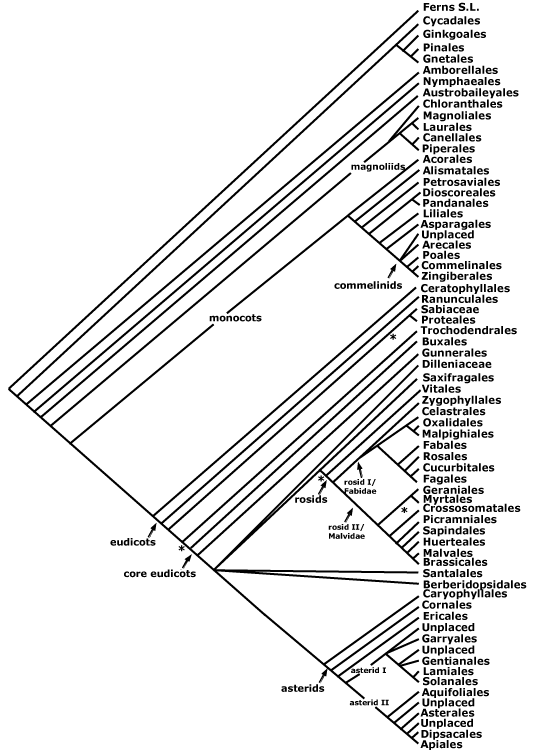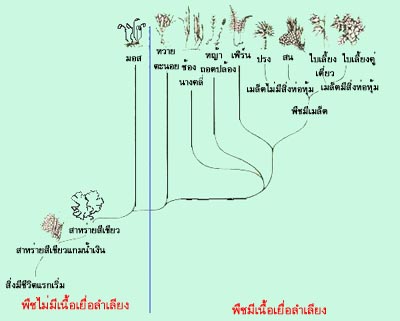 |
#11 ข้อความใต้ภาพเป็นแบบนี้ครับ
The Main Tree above is a conservative summary of well supported relationships between the major clades of extant seed plants. "Reading" - interpreting and understanding - such a phylogenetic tree is not necessarily easy, so "reading a tree" may require a bit of practice. O'Hara (e.g. 1988, 1992) provides an accessible introduction to thinking and talking about history in the context of looking at phylogenetic trees. More recently, Krell and Cranston (2004), Crisp and Cook (2005) and others have emphasized how careful one must be when interpreting and talking about evolution in ladderized trees in particular and phylogenetic trees in general; Gregory (2008) provides a particularly detailed discussion of this problem. In ladderized trees the smaller (in terms of numbers of terminals) sister taxon is consistently shown on the same side at every node, thus the trees tend to be pectinate like the teeth of a comb, however, the horizontal axis that is as a result so evident has no polarity or particular direction. The use of the adjective "basal" when discussing phylogenetic trees is especially dangerous (see also Wojciechowski et al. 2004; D. Soltis et al. 2005b). When I use the term, and the context is not otherwise clear, I am referring to the pectinations at the base of a ladderised tree. Remember that when talking about sister tax:-) can never be basal to the other, or older or younger, although members of one can be more derived - in the sense of having more apomorphies - than the other (but even then one has to be careful). The words "primitive" and "advanced" and "lower" and "higher" should practically never be used, especially when talking about taxa. Amborellaceae and Pinaceae are sister to all other flowering plants and Pinales and are basal to the crown groups of all other flowering plants/Pinales, respectively, but that does not mean they are thereby "primitive"; Pinaceae in particular have numerous apomorphies. The word "plesiomorphic" is far less loaded than primitive, and can be used to talk about individual characters.
Most trees here have been more or less ladderized, as is the one above. The ladderization may be imperfect, for example, you can see that on the Main Tree asterids, with ten orders, follow rosids and relatives, which have seventeen, although this is in part because of the currently unresolved nature of relationships between the main clades of core eudicots (this is likely to change soon). The Main Tree could have been drawn with Amborella, Acorus, or a host of other taxa at the far right without offending any relationships; phylogenetic trees are like mobiles, the only fixed points being the nodes. Despite the problems just mentioned, pectination, interpreted carefully, has its value, and it is not an arbitrary process. As one reads the terminals of a pectinate tree from left to right, adjacent terminals will be separated by apomorphies that will cumulate in an appropriate fashion. When thinking of a book or a herbarium sequence (see Haston et al. 2007), this is of some value. Nymphaeales and Austrobaileyales are here adjacent on the tree, but they could be separated by hundreds of families in the sequence merely by rotating only the node from which Nymphaeales and their sister group (all other angiosperms minus about 75 species!) arise. If adjacent in a book or herbarium or as in these summary pages, then it is relatively easy to relate their characters, both apomorphic and plesiomorphic, but if separated by hundreds of pages, or two floors in a large building, then it is less easy to get anything from the sequence. (Since all orders in the pages of the main part of this site are preceded by the apomorphies of all nodes immediately below them in the seed plant phylogeny, and because of the linkages that have been built in to the site, this problem is much less serious there; there is no sequence.) So the particular sequence of all seed plants that is based on a phylogenetic classification but is to be used in herbaria or any other place where taxa have to be arranged linearly, as in this part of /APweb/, will be one that maximizes the number of taxa that are both successive branches of the tree and placed successively in the sequence. Since specimens are generally filed under families, the outline of a new family sequence for arranging herbaria and books can now be suggested (Haston et al. 2007), and such a standardized sequence will further help teaching and learning about plants.
ส่วนเรื่องความห่างในระดับยีนไม่จำเป็นต้องแปรผันตามระดับวิวัฒนาการถูกแล้วแหละครับ เพราะบอกได้แค่การเปลี่ยนแปลงของยีนมากน้อยแค่ไหน ส่วนระดับวิวัฒนาการต้องไปดูที่สภาพแวดล้อมประกอบด้วย
| จากคุณ |
:
silverspider   
|
| เขียนเมื่อ |
:
15 ธ.ค. 54 16:27:23
|
|
|
|
 |







